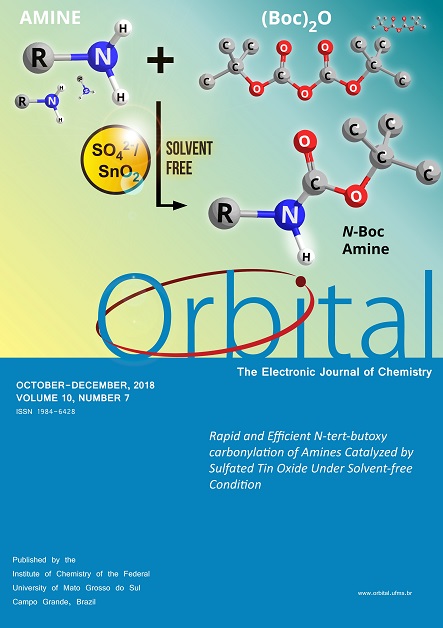Botryosphaeria spp. as Producers of Laccase When Cultivated on Vegetable Oils as Sole Carbon Source: Optimizing Laccase Production by Botryosphaeria rhodina MAMB-05 on Soybean Oil
- Botryosphaeria rhodina MAMB-05,
- laccase,
- soybean oil,
- glycerol,
- response surface methodology
Copyright (c) 2018 Orbital: The Electronic Journal of Chemistry

This work is licensed under a Creative Commons Attribution-NonCommercial-NoDerivatives 4.0 International License.
Abstract
Eight vegetable oils and glycerol were examined as sole carbon source to screen nine isolates of Botryosphaeria spp. Among these, B. rhodina MAMB-05 produced highest laccase titres on all carbon sources evaluated followed by B. rhodina MMLR isolated (from orange, Citrus sp.). The influence of inorganic nitrogen (NH4Cl, NaNO3, (NH4)2SO4, and NH4NO3), organic nitrogen (yeast extract (YE), urea, peptone, and corn steep liquor) sources, inorganic phosphate (KH2PO4, Na2HPO4, NaH2PO4, K2HPO4), as well as increasing concentrations of copper (from zero to 100 µg mL-1), as nutritional requirements for enhancing laccase production by B. rhodina MAMB-05 were also evaluated. Soybean oil was the only carbon source in a central composite factorialdesign (23) to optimize laccase production with the selected variables NaNO3, KH2PO4 and copper (CuSO4.5H2O), using the response surface methodology. The optimal conditions obtained were NaNO3 (100 g L-1), KH2PO4 (125 g L-1) and 50 µg mL-1 of CuSO4.5H2O. The specific laccase activity obtained (2.95 U mg-1) in the validation experiments using the optimal condition for laccase production by B. rhodina MAMB-05 was in agreement with the predicted value (3.07 U mg-1), and demonstrated the fitness of the proposed model.

